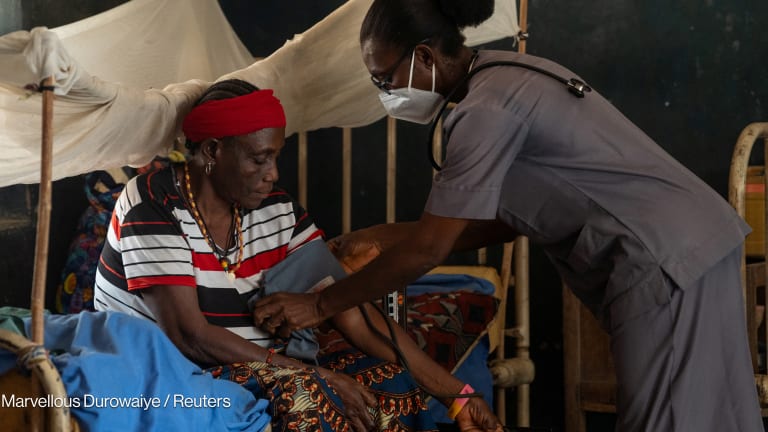
WASHINGTON — The U.S. State Department’s plan for implementation of the Trump administration’s U.S. Strategy on Women, Peace, and Security, more than 100 days overdue, are finished and ready to be submitted.
The plan will be submitted along with complementary plans from the U.S. Agency for International Development, the Department of Defense, and the Department of Homeland Security for approval from the White House, according to Amanda Van Dort, senior adviser for women, peace and security in the State Department Bureau of Conflict and Stabilization Operations.
“Our implementation plan should be released publicly and submitted to Congress in the next couple of weeks. The reason for the delay is we’re trying to coordinate; we want all four departments and agencies’ implementation plans to be submitted together at the same time,” Van Dort said. “The Department of State’s is already completed.”
The implementation plans were due in October 2019 as mandated by the Women, Peace, and Security Act that Congress passed in October 2017. The legislation required the administration to develop a WPS strategy within one year and then release the implementation plans 180 days after that. The strategy was not released until June 2019, a year and a half late, pushing back the clock on action required by the bill.
“Our understanding ... is that the meat of the programs and the policies were going to come from the implementation plans.”
— Megan Corrado, director of advocacy, Women for Afghan WomenThe bipartisan WPS Act is the first legislation in the world of its kind, mandating U.S. support for political participation of women in fragile environments and in conflict prevention and resolution. It codified into law prior efforts of the U.S. government to implement United Nations Security Council Resolution 1325, a roadmap for the global WPS agenda that passed in 2000.
The U.S. WPS strategy laid out four main lines of effort: seeking and supporting preparation and participation of women in decision-making processes; promoting human rights protection of women and girls; improving equality and empowerment outcomes for women through U.S. international programs; and encouraging other governments to adopt similar WPS plans.
Holding the administration accountable
Civil society, which lauded passage of the WPS Act, was skeptical when the Trump administration WPS strategy was released last year, said Megan Corrado, director of advocacy at Women for Afghan Women.
“There was a little bit of concern when strategy came out … basically at every turn the government has failed to meet the legal requirements of the WPS Act,” Corrado said. “When the strategy did finally come out, many of us in civil society thought it was really bare bones. It lacked a lot of detail, there was a lot of ‘as appropriate’ language, which was concerning … That said, I think our understanding meeting with the agencies is that the meat of the programs and the policies were going to come from the implementation plans.”
Corrado leads the U.S. Civil Society Working Group on WPS, made up of about 50 civil society organizations, which was closely involved with the drafting of the WPS Act and ensuing strategy consultations.
Chantal de Jonge Oudraat, president of Women in International Security, said the WPS strategy had a “traditional” way of looking at the WPS agenda, instead of taking an approach that acknowledges gender inequality. Out of the agencies responsible for implementing the strategy, she said that some have a better track record on gender than others.
“What we would be looking for in these implementation plans is if there is any benchmark by which the agencies can be held accountable so that there is concrete and precise language and what their list of priorities is going to be,” said de Jonge Oudraat, noting that she also hopes consultation of civil society is meaningful and not “just ticking off a box.”
Van Dort said accountability will be key to the administration’s WPS agenda, so that civil society can monitor the agencies’ progress on implementation. The implementation plans are central to this, she said, so the public knows exactly what the State Department is committing to achieving.
“[The implementation plan] demonstrates this administration's commitment to the issue,” Van Dort said. “You need a policy framework that sets out publicly for everyone to see what the administration’s priorities are in this space.”
“We have a real-life example where lack of implementation plan, policies, and funding is undermining a current peace process in real time.”
— Megan Corrado, director of advocacy, Women for Afghan WomenThe implications of the delay
The implementation plans also help ensure that the State Department, USAID, DOD, and DHS work together to ensure each department fits into a cohesive, larger picture WPS strategy. While the agencies didn’t clear one another’s plans, the White House led small group meetings to discuss the role each agency should take in implementation.
USAID did not provide specifics when asked by Devex about the status of its implementation plan, but Acting USAID Spokesperson Pooja Jhunjhunwala said, “USAID is working closely with the interagency under the auspices of the White House to finalize our respective Implementation Plans.”
Van Dort said the U.S. government suffers from “an abundance of strategies” on related peace and conflict issues like counterterrorism, countering violent extremism, and stabilization, which can cause bureaucratic delays in making recommended operational changes. But she said it is important that the WPS strategy feeds into other work, like the 2018 Stabilization Assistance Review, led by the Bureau of Conflict and Stabilization Operations, known as CSO.
“We talked a lot about who was going to cover what, but mainly how they were going to be complementing each other. And I think actually CSO’s leadership in the SAR is really important for this, because it shows if you look at the SAR, it’s saying that there’s an element of [civilian-military] coordination that is so critical especially in conflict,” Van Dort said. “I think a lot of the lessons from the SAR are really important for this civ/mil collaboration even in the WPS space — if we can get it right.”
Corrado said the delay in releasing the WPS implementation plans has implications in ongoing peace processes around the world that aren’t benefiting from an approach that puts women more squarely at the center of peace efforts, like those in Afghanistan.
“We have a real-life example where lack of implementation plan, policies, and funding is undermining a current peace process in real time where the U.S. is not really meaningfully empowering and engaging women in their talks with the Taliban,” Corrado said.
Despite the significant delays in having the implementation plan approved by the White House and publicly released, Van Dort said her agency has not been prevented from moving ahead with the work that needs to be done to ensure women are meaningfully integrated into peace processes. She also said that even though the WPS Act did not include a budget line item to fund WPS — a criticism of civil society — the State Department and USAID are currently spending about $138 million on WPS programming.
“For department and CSO, we’re already doing our work,” Van Dort said of her bureau. “We’re not waiting on the implementation plan to start.”
Updated 1/22/20: This article has been updated to clarify the State Department’s implementation plan process.








